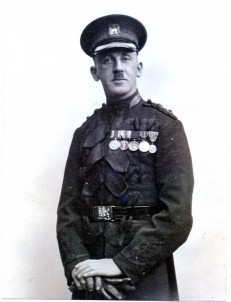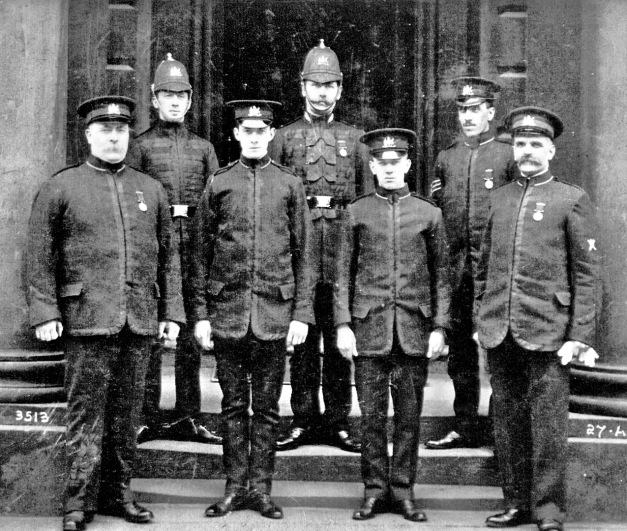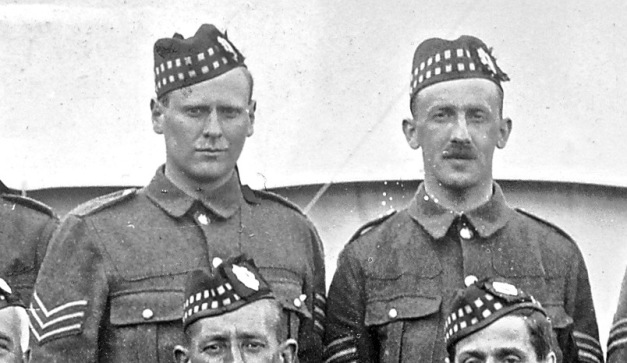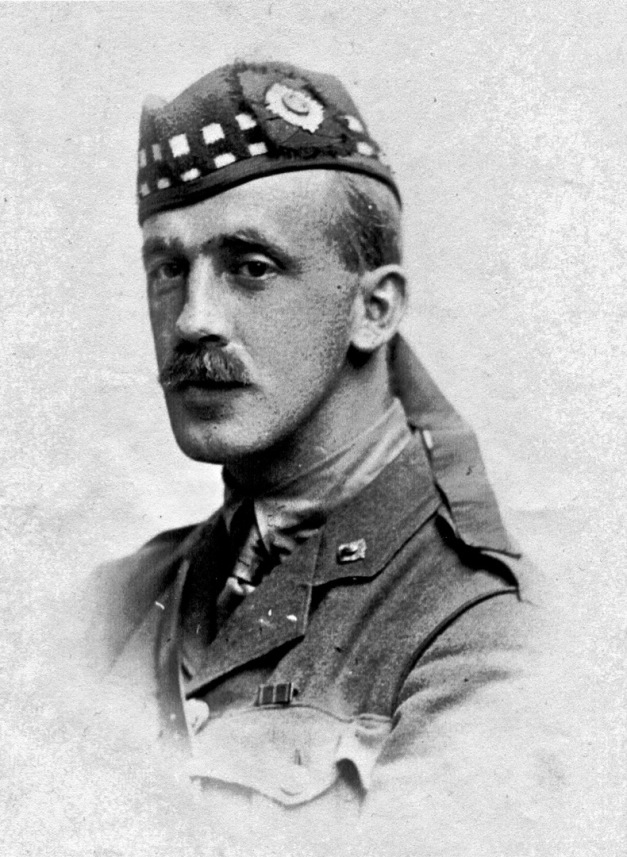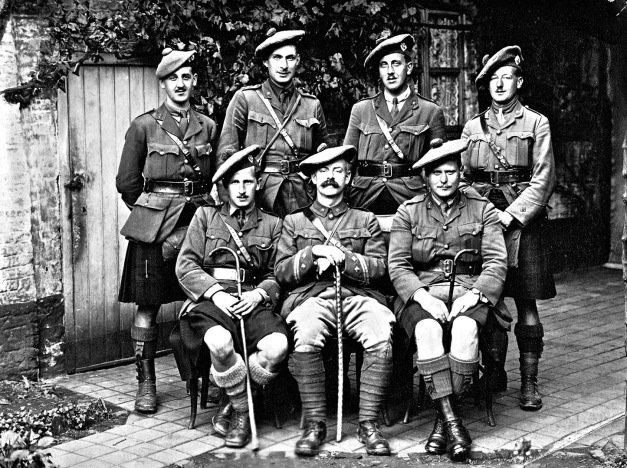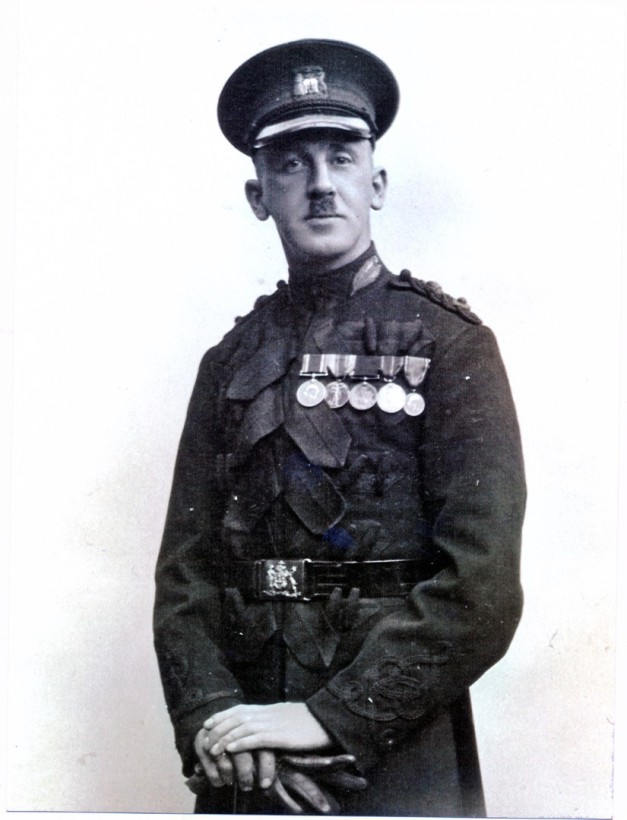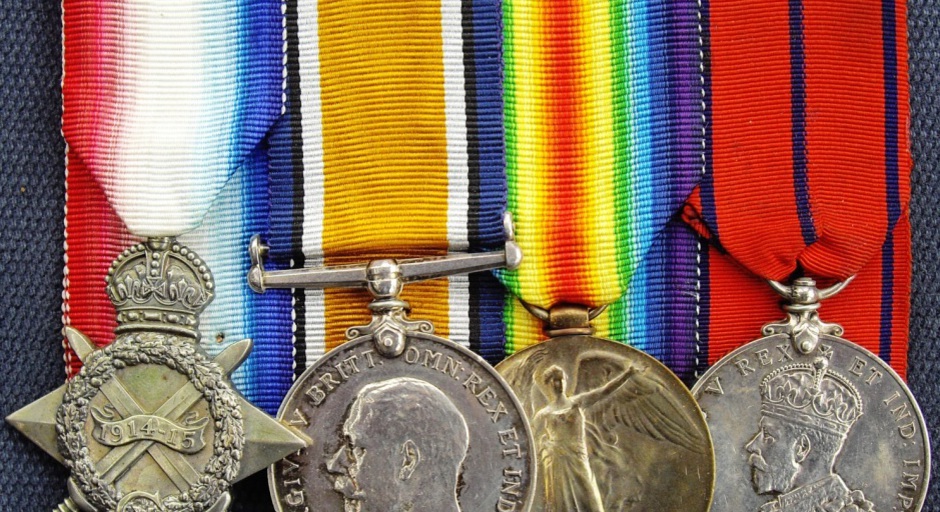
Edinburgh City Police - Lieutenant Matthew Peacock
Edinburgh City Police
Superintendent Matthew Peacock
British War Medal
Victory Medal
King Edward VII Police (Scotland) Medal, 1903 [i]
King George V Coronation (Scottish Police) Medal, 1911
Unidentified Medal [ii]
Silver War Badge No. 341157
The Early Years
Matthew Peacock was born on 14 September 1884 in Guisborough, Yorkshire. He was the son of William Henry Peacock, a self-employed Carrier and Jane Ann Wiley or Peacock. The couple had been married 28 years by 1911 and had five children together, one of whom had died before that year.
In the Census of 1901 when he was 16 years old, Matthew was employed in the family firm of Carriers. In the same year, William Henry’s brother Robert was Chief Constable of Manchester.
[i]PC Matthew Peacock joined Edinburgh City Police too late (2 October) in 1903 to be entitled to the 1903 medal commonly known as ‘The Visit to Scotland Medal’. The medal was awarded for service during the Royal Visit of May that year. Rather uniquely, there is no medal entitlement recorded on Lieutenant Peacock’s ECP personnel record.
[ii]This unidentified medal to the right of the 1911 medal is not recorded in his Edinburgh City Police personnel record and the ribbon looks like a King George V Jubilee Medal which was not awarded until long after he had retired from the police.
Edinburgh City Police
Matthew Peacock joined Edinburgh City Police on 2 October 1903 as a 5th Class Constable on 25/- per week. His previous occupation was ‘Clerk’, he had only just turned 19 the month before and he was 5’ 9” with ‘brown hair’, ‘brown eyes’ and a ‘fair complexion’. He was initially attached to the Chief Constable’s Office as a Clerk. On 26 September 1905, he was ‘Specially advanced to 2ndClass, 1st Grade Constable @ 29/- per week’.
Promotion to Sergeant
On 22 May 1906, Matthew was promoted to Clerk Sergeant, still in the Chief Constable’s Office.
Promotion to Inspector
On 5 April 1910, he was promoted to Inspector 3rd Class on £120, per annum, still in the Chief Constable’s Office.
Promotion to Lieutenant
On 15 November 1911, he was promoted to Lieutenant and Chief Clerk when still only 27 years, on £160 per annum.
Resignation to join the Army
Lieutenant Matthew Peacock resigned from Edinburgh City Police on 25 May 1915 ‘for the purpose of joining the Army’ having enlisted as Private Number 3196 in the 6thBattalion the Royal Scots (Lothian Regiment), part of the Territorial Force on 20 May.
Promotion to Acting Sergeant
On 29 May 1915, Matthew Peacock and William B. R. Morren were appointed Acting Sergeants in the battalion. Their picture at this time can be seen below. Just short of a month later, having been recommended for a Commission, both were discharged and received the King’s Commission as 2ndLieutenants in the 6thBattalion the Royal Scots.
Active Service in France and Belgium 1916 – 1918
His commission was published on page 6148 of the Supplement to the London Gazette, 23 June 1915 to take effect from 24th. The 6th Battalion was employed on Coastal Protection Duties at Selkirk, Peebles and Portobello.
He was a witness of the wedding of William B. R. Morren and Grace Evelyn Thorburn Falconerwhen they married at the Carlton Hotel, Edinburgh in 1916.
He was transferred to the 9th (Highlanders) Battalion Royal Scots (RS) and joined them in France on 3 August 1916. The 9th Battalion, although a Lowland Regiment, was a ‘kilted’ unit and he can be seen in that uniform in the pictures below.
The 9th Battalion was part of the Lothian Coast Defence Brigade when it deployed to France in late February 1915 joining the 27th Division with whom it took part in the Second Battle of Ypres, alongside the 1st Battalion, losing over 200 casualties. The Battalion transferred to the 5th Division in late November 1915 and then to 154 Brigade of 51st Highland Division on 1 March 1916 remaining with them until February 1918.
Their baptism of fire with the Division came during the First Battle of the Somme with the attack on High Wood on 23 July 1916. Their next major involvement was the Battle of Arras in April-May 1917 where the 9th RS on 9 April, were initially the right assault battalion tasked to capture the first line of German trenches at the south end of Vimy Ridge. They achieved their objective after a stiff fight. Later they were heavily involved in the Scarpe and Roeux battles. Before leaving the 51st Division the Battalion took part in Third Battle of Ypres and the operations at Bourlou Wood and Cambrai.
Medical Discharge
Lieutenant Matthew Peacock, then serving with the Labour Corps in France, was discharged on 5 April 1918 ‘on account of ill-health contracted on active service and granted the rank of Lieutenant’.
As a result of his having arrived in France on 3 August 1916 and his subsequent time there, Matthew Peacock was awarded the British War Medal and Victory Medal and these are referenced on his Medal Index Card showing that he served in 6th Royal Scots as a 2nd Lieutenant, the 9th Royal Scots as a Lieutenant and Acting Captain and as a Lieutenant in the Labour Corps.
As a result of his medical discharge from the Army, he was approved as eligible for the award of a Silver War Badge, No. 341157 on 19 April 1918.
Re-appointment to Edinburgh City Police
Matthew Peacock was “Re-appointed with 2 years and 355 days Army Service together with former Police Service counting towards pension and promoted to the rank of Superintendent 4th Class @ £220 per annum”. Three months later, he was advanced to 5th Class Superintendent at £270 per annum.
Transfer to A Division as Chief Clerk
On 16 June 1919, Superintendent Peacock was transferred to A Division (the HQ of which, was also in the Force HQ in Parliament Square) as Chief Clerk. He remained in that appointment until 1925.
Transfer to D Division
On 28 April 1925, Superintendent Peacock was transferred to D Division. The HQ of which, was then in Torphichen Place at the West End Police Station. After the introduction of Police Boxes in 1933, the ‘West End’ became C Division HQ.
Retirement on Medical Grounds
On 11 March 1927, Superintendent Matthew Peacock retired from Edinburgh City Police. The Scotsman newspaper of 17 March 1927 reported that:
“Supt. Peacock, of D Division of the Edinburgh City Police, has in consequence of poor health, had to retire after 24 years’ service. Mr Peacock served in the Army during the war, and was invalided out, and since then, his health has not been good.
Supt. Peacock is a nephew of the late Chief Constable of Manchester who has left him the silver casket and address presented to Sir Robert by the citizens of Manchester; his presentation sword from Oldham; his address from the Chief Constables Association; and his Victorian Order and presentation medals.
Consequent upon the retirement of Supt. Peacock, several promotions are notified. Inspr. Colin Brown (A) has been appointed Superintendent in charge of D Division; Sergt. Allan Campbell (A) has been promoted Inspector; and Constable Robert Anderson (E) Sergeant.”
The End of the Story
After he left Edinburgh City Police, the only trace I have found of Matthew Peacock, apart from his death, was in the 1939 Register of England and Wales taken at the start of World War 2. He and Emmie Peacock were living at 280 Warminster Road, Croydon in Surrey. His occupation was ‘Assistant Air Raid Precautions Officer’.
Matthew Peacock died in London on 1 June 1966.
